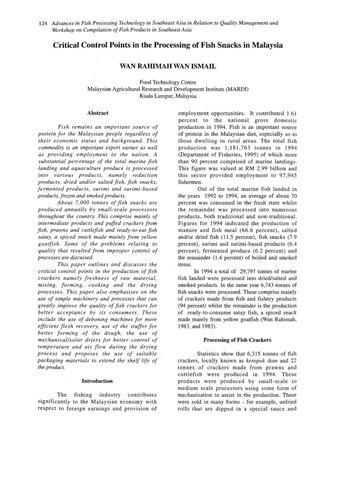Critical control points in the processing of fish snacks in Malaysia
Share
Abstract
Fish remains an important source of protein for the Malaysian people regardless of their economic status and background. This commodity is an important export earner as well as providing employment to the nation. A substantial percentage of the total marine fish landing and aquaculture produce is processed into various products, namely reduction products, dried and/or salted fish, fish snacks, fermented products, surimi and surimi-based products, frozen and smoked products.About 7,000 tonnes of fish snacks are produced annually by small-scale processors throughout the country. This comprise mainly of intermediate products and puffed crackers from fish, prawns and cuttlefish and ready-to-eat fish satay, a spiced snack made mainly from yellow goatfish. Some of the problems relating to quality that resulted from improper control of processes are discussed.This paper outlines and discusses the critical control points in the production of fish crackers namely freshness of raw material, mixing, forming, cooking and the drying processes. This paper also emphasises on the use of simple machinery and processes that can greatly improve the quality of fish crackers for better acceptance by its consumers. These include the use of deboning machines for more efficient flesh recovery, use of the stuffer for better forming of the dough, the use of mechanical/solar driers for better control of temperature and air flow during the drying process and proposes the use of suitable packaging materials to extend the shelf life of the product.
Suggested Citation
Ismail, W. R. W. (1997). Critical control points in the processing of fish snacks in Malaysia. In K. K. Hooi, L. K. Low, & P. Y. Lim (Eds.), Proceedings of the seminar on the advances in fish processing technology in Southeast Asia in relation to quality management, Singapore, 29 October - 1 November 1996 (pp. 124-127). Singapore: Marine Fisheries Research Department, Southeast Asian Fisheries Development Center.

